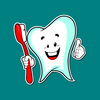Baby's teeth
The first teeth usually appear around 6 months. However, they can appear earlier or later. The appearance of teeth is a source of many questions for parents, and this article aims to answer the main questions. If you have any other questions, please don't hesitate to ask us.
The development of the teeth
It is in the 6th week of pregnancy that the buds of the milk teeth appear and it is in the 10th week that the buds of the definitive teeth begin to be created.
The different parts of the baby tooth will be formed during the pregnancy while the construction of the permanent tooth starts only after the birth or even 5 years later for some molars.
Most of the time, the 20 milk teeth will appear one after the other from 6 months to 3 years. In general, however, they come out in the following order:
- The two lower incisors, then the upper ones (between 6 and 12 months);
- The lateral incisors (between 9 and 13 months);
- The first molars (between 13 and 19 months);
- Canines (between 16 and 22 months);
- Second molars (between 25 and 33 months).
The diagram below summarizes the order of appearance of the teeth:

Adult or permanent teeth will appear between the ages of 6 and 12.
Teething
Teething symptoms:
A flare-up should be suspected when your child:
- Saliva a lot
- Wants to nibble all the time
- Has red cheeks
- Cry more often
- Eat less well than usual
- Sleeps less well
- Has swollen gums with the presence of a small blue bubble that announces the next dental breakthrough.
- Sometimes a low fever, but never a high fever. In case of high fever, consult a doctor.
Relieve teething:
- Gently rub your child's gums with a washcloth moistened with cold water.
- Give your child a refrigerated teething ring to chew on. Be careful not to put it in the freezer to prevent your child from getting hurt. Do not dip it in sugar or honey either...
- Reassure your child.
Brushing your teeth

We advise you to brush your little one's teeth as soon as the first teeth appear. This will get him used to brushing his teeth. This brushing must be done with an adapted toothbrush. It is recommended to do it once or twice a day and especially in the evening.
We also recommend that you do not put your child to bed with a sugary drink to limit the risk of cavities. Babies' teeth are already in close contact with sugary drinks and the risk of developing cavities is high. This is because bacteria in the mouth turn sugary drinks into acids that will attack the teeth and cause cavities.

